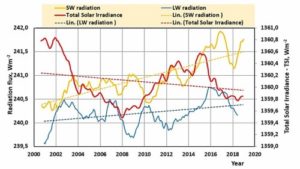by Dr A. Ollila, March 16, 2020 in ClimateChange Dispatch
During the years 2000-2014, the global temperature hardly increased, and that period has been called the temperature pause or hiatus.
The debate among the climate community has resulted in more than 200 research studies in some cases with opposite results about the reasons.
This amount of papers can be compared to the research studies of Earth’s energy balance and the greenhouse effect. I have found about 10 publications for both subjects.
During the years 2000-2014, the emissions of carbon dioxide were 126 gigatons carbon (GtC) being 31% of the total emission after 1750, but the greenhouse (GH) gases were not able to increase the temperature.
According to the IPCC, the temperature increase should have been 0.4°C from 2000 to 2014 (Ref. 1).
It looks like that the pause ended to the super El Nino 2015-2016 because the temperature has been thereafter about 0.2 °C above-the-pause average.
Research study about the pause and the ENSO
The impulse for my research study came from a story figure on WUWT that showed shortwave (SW) radiation variations during the pause.
A curve showed increased values around El Nino 2015-16 and thereafter. I decided to find out what could be the impact of this finding on the temperatures.
In Fig. 1, I have depicted the total solar irradiance (TSI), SW radiation and LW radiation from 2000 onward. This data is available from the CERES databank maintained by NASA.

Fig.1. TSI, SW radiation and LW radiation trends normalized to the altitude of 20 kilometers.
…
